Wairere ewes with purebred Nudie lambs at eight weeks old
Sheep farmers are under siege. A siege caused by a combination of falling prices, fast rising costs, and a government determined to frame livestock farmers for a crime against the world climate…blame the animals! Meanwhile, the politically constructed carbon market is prompting a flood of farm sales to pine trees. Where’s the upside?
Farm gate prices are determined by supply and demand, competitors and substitutes. It may be a year before life in China returns to a pre-Covid normal, and Europe starts to recover from the huge increase in energy prices. International beef prices have held up well, which is encouraging. Large increases in costs will reduce the global area planted in grain, and yields, prompting inflation in food prices around the world. There is talk that “the USA will be short of meat next year“. Against that background, a 14.8 million increase in Australian sheep numbers over the past three years will lead to Australian lamb exports leapfrogging New Zealand tonnage for the first time ever.
But there will continue to be strengthening demand for protein. The recent drop in farm gate price for sheep meat will be short lived. In this environment, how can Wairere rams reduce your workload and improve your profitability and lifestyle?
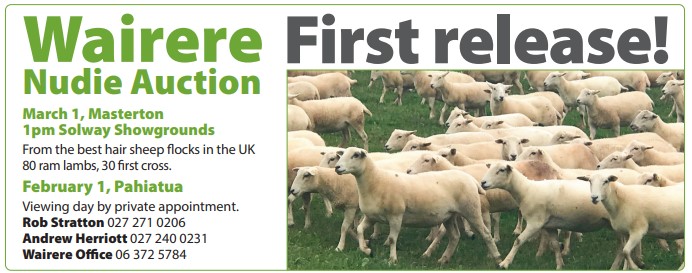
New release! First ever Nudie auction:
Mark March 1 on your calendar, the date of the first Wairere sale of purebred Nudie ram lambs, imported from the UK as embryos. Most of the work and cost with sheep farming is because of wool. From 2019 to 2022 Pierre Syben searched the UK and Ireland for the most suitable Hair sheep to import to New Zealand. He focused on large flocks run outdoors year round, with minimal shepherding. The New Zealand Wiltshire flock has been bred from a very small genetic base, and is in urgent need of genetic diversity.
There will also be first cross Nudies available for purchase. These ram lambs have been bred from three groups: Bare Wairere Romney ewes, FE resilient ewes, and Tufguy (Texel/Romney) ewes. The first cross captures many of the advantages of Nudies, but exploits hybrid vigour and maintains an annual fleece, and could be bred back to Wairere Romney if strong wool makes a comeback in value. There will be thirty first cross Nudie ram lambs for sale on auction day, ten from each group. And up to eighty purebred ram lambs. On March 2, the day after the auction, there are a number of clients coming to Wairere to buy first cross Nudies at scheduled times.
Open day
There will be an opportunity to view purebred and first cross Nudies a month before the auction, on February 1. A farm near Pahiatua, visit by invitation only (Wairere office, 063725784, or ring Rob Stratton on 0272710206, or Andrew Herriott on 0272400231). Time: 10am to 1pm. Pierre Syben is flying in from Wairere Australia to host the day. The ram lambs will also be eye muscle scanned and weighed on that day, so you will be able to see those measurements first hand. The mean birth date was September 14th, so average age at eye muscle scanning will be 20 weeks. On sale date on March 1 the ram lambs will be 24 weeks average age. For information about the genetic background of the Nudies imported in 2022, read below, a repeat of the Wairere newsletter in May 2022.
How good are these genetics?
Pierre Syben spent three seasons for WairereUK selling Wairere Romney rams in the UK and Ireland, 2019-21. During that time he visited the key Hair sheep breeders in the UK and Ireland. From that due diligence, Pierre selected sixty eight ewes for Multiple Ovulation Embryo Transfer.
- From Hayden Woolley (an unusual name for a Hair sheep breeder!) in central England Pierre selected 60 out of 600 two tooth ewes which had all reared lambs as hoggets. These two tooths have hair rather than wool, so Hair sheep rather than shedders, no handpiece work required. 392 embryos.
In 2016 and 2017 Hayden had the pick from Iolo (pronounced Yollow) Owen’s two tooth ewes, as Iolo sold out his flock in Wales, retiring from active farming in his eighties. Iolo is known as the father of No Wool sheep. Hayden bought 700 two tooths each year. Pierre took particular care to select ewes with sound structure and black feet. He selected ewes which grow hair rather than wool. Shedders are disliked in the UK, because wool accumulates on fences and makes their surroundings look untidy.
Hayden Woolley started grazing 60 sheep on rented land and increased that to 6,000 ewes by forty years old. One day his head shepherd announced that he was leaving, and the other two shepherds handed in their notice that evening. At that time Hayden had 3,000 Kent Romneys and 3,000 Hair sheep. The Romneys scanned 160% and tailed 140%, with lambs finished at 19.5kg. The Hair sheep scanned 170% and tailed 150%. Lambs were finished to the same weight, though slightly slower growing than the Romneys. It was a no brainer to switch to all Hair sheep. Hayden: “ Hair sheep cost £10 less per year to farm. More than 80% of the work with sheep is because of wool.”
- From Barry Sangster’s Signet recorded flock in northeastern Scotland, embryos were transferred from 3 two tooth ewes, 2 of them with double Myomax (Texel muscling gene). 16 embryos
- From Tom Welch’s SIL recorded flock on the Scottish Borders Pierre chose 5 five to seven year ewes with a strong background of lambs reared. 50 embryos.
On the ram side, sires for both the embryos and semen came from a variety of sources:
- One from Dr. Steven Johnston in Northern Ireland, recorded on Ireland’s sheep recording scheme. Steven is Senior Beef and Sheep Technologist, Greenmount Campus.
- Four from Tom Welsh, Scotland, recorded on SIL.
- One from Barry Sangster, Scotland.
- One from Campbell Tweed in Northern Ireland. Campbell has 2,000 recorded Easycare ewes, recorded in both Ireland and Britain.
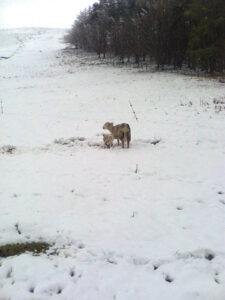
From small beginnings … a Nudie hogget with lamb, Scottish borders
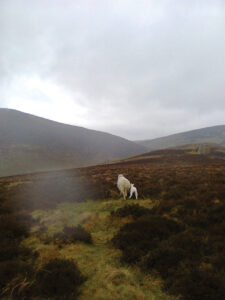
Tom Welsh’s Mossfennon farm, mostly heather country on the Scottish borders, sheep run outdoors all year round.
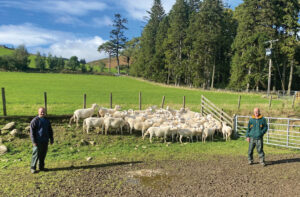
Sandy Welsh and son Tom, Mossfennan farm, with the forty five year and older SIL recorded ewes that Pierre selected for MOET in October 2022
What about next year?
In September Pierre flew a four and a half day round trip from Wairere Australia to Scotland to select 40 five year old ewes or older from Tom Welch’s Mossfennan Farm in the Scottish Borders, using New Zealand SIL figures (Sheep Improvement Ltd breeding values). Pierre also had the pick of the 2021 drop sires, selecting two on maternal traits and one on carcass traits.
Canterbury based scanner and sheep breeder Daniel Wheeler scanned Tom’s flock pre Covid, and was back there in mid January this year after a gap of three years. Daniel, “I like the way Tom runs his sheep, outdoors year round in heather country, testing the feet in long summer grass and heather, and testing constitution in the winter. He has continually increased stocking rate, so the ewes are not big, just 60-62kg average. Tom’s Hair sheep have gradually replaced his Scottish Blackface flock”.
Wairere has also collected multiple embryos from 25 ewes in Hayden Woolley’s flock, so we have 478 embryos to implant in autumn this year. And we have collected semen from some different sires to last year. Pierre also bought two more Nudie ram lamb sires from Steve Johnston in Ireland.
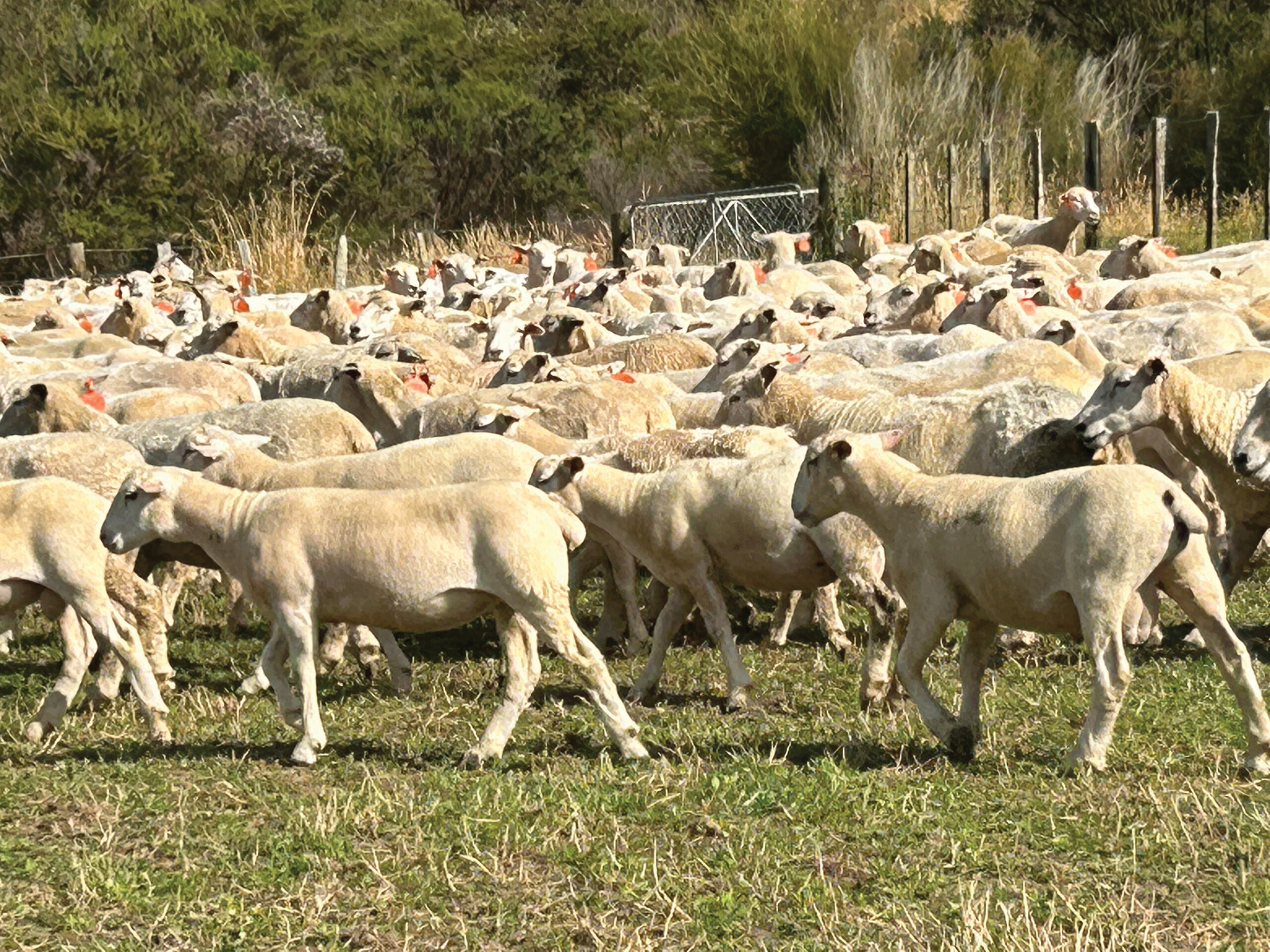
Pure bred Nudie lambs with ewes, January 24th 2023, nineteen weeks old
Adapting to change
All costs have risen, especially interest rates, fertiliser, fuel, and wages. We can’t do much about interest rates, apart from getting out of debt. Fuel is not a major direct cost for hill country farms. Wages require a rethink towards minimising the requirement for people. Adaptations to the cost/price squeeze may include setting up smaller farms to farm part time, increasing scale on larger farms, and finding a new balance between stocking rate and inputs.
How much fertiliser to apply? And what type? Wairere has used a small input of nitrogen per hectare for nearly fifty years, but the cost of nitrogen has more than doubled. It could be a prompt to cut out N and reduce stocking rate.
The Regen brand
In December Regenerative Farming monitor Bruce McGregor spent a day at Wairere, examining soil samples in ten representative paddocks, taking six 30cm soil test cores and checking out thirteen ecosystem indicators at each site. The indicators include soil porosity, soil structure and friability, pasture root depth, worms and other soil life, litter in the soil and above ground, number and variety of pasture species, presence of trees which encourage more species of insects and birds, a soft soil surface, (pliable, rather than crusty), no bare soil without plant cover. These sites will be checked annually for changes in soil and pasture health. An eleventh, more intensive, site was set up to monitor changes over a four year period.
Lambs from approved regenerative farm suppliers to Lean Meats/Atkins Sheep Ranch are eligible for a premium on pelts, wool and meat amounting to around a dollar per kg. The Savory Institute is not prescriptive on inputs, so is not against New Zealand’s traditional farming practices. The sites simply monitor the changes in soil health, and may lead to cost effective adjustments to management. By early 2022 there were 63 Lean Meats’ lamb suppliers being monitored, most with a positive outcome. Part of the Regen story is the important role that grazing animals play in returning organic matter to the soil. Organic matter is typically six to seven percent under New Zealand pastoral systems, but as low as one percent where soils have been continuously cropped with wheat for decades. The vegetarian movement seem unaware of the dangers of over reliance on plant crops, given the huge number of sprays used to combat weeds, fungi and insects. There is an historic reason that cows are sacred in India, and why there are 305 million cattle and buffalo cohabiting with the
world’s largest human vegetarian population.
Idealism versus realism
The government plans to spend $54 million on researching Regenerative farming principles. Is that necessary, given what’s happening in the private sector? And the Greenhouse Gas Consortium has used $200 million of taxpayer funds to date. For what result? The sheep with lower emissions may have a smaller rumen, less suited to digesting low ME pasture? The unintended consequence might be to breed sheep which are less resilient to environmental adversity. Is the methane measurement trailer for ram breeders just an exercise in “keeping the peasants busy” while taxing farmers on any pretext?
In the bigger picture the Labour government celebrated an $11 billion blowout for the year to September, saying that “it could have been $22 billion”. $11 billion is exactly the same on a per capita basis as the £70 billion that British PM Liz Truss was deposed for, but there was no media exposure here on the deficit in New Zealand.
Our ideologue government has taken the opposite approach to much richer Norway, which continues to explore for oil and gas, and has been able to help Europe with energy supply during the Ukraine war. Meantime, New Zealand gives foreign owned companies like NZ Steel and Rio Tinto’s aluminium smelter carbon holidays until 2037, while pushing up prices and taxes on citizens. The close down of the refinery has cut across local supply of sulphur for fertilisers, carbon dioxide for fizzy drinks plus preservation of vegetables and meat, and bitumen for roads. The drive to make New Zealand “poorer faster” than other countries, and more dependent on imports, doesn’t make economic sense. The net result will be the emigration of many young and talented New Zealanders to more prosperous economies.
Competing for land use
Within several years there will be around 1,600ha of pine trees planted on Wairere’s western and northern boundaries. That will leave less than ten percent of our boundary adjacent to pasture. The money from carbon forestry is very tempting. So tempting that the annual cut of Pinus radiata is predicted to fall from 35 million tonnes now to 25 million in ten years time. Sheep and beef export tonnage will be down too, so there will be reduced export income available for imports. Meanwhile the environmentalists’ concept of a circular economy is proving disappointing. Eucalypt wood chips in Southland are not as efficient at providing heat for industrial use as predicted, around seventy percent of forecast. In the lower North Island there is a lot of diesel being burned to transport forest slash and then chip it for use in boilers. If you can’t beat them, join them? A hundred or two hundred hectares of pines on a sheep farm could be the best diversification available, especially if a proportion of the carbon can be forward sold.
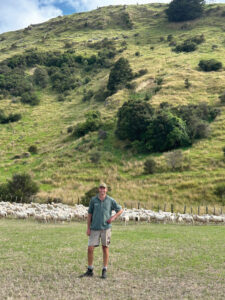
“Two metre” Peter Apthorp with Nudies near Pahiatua. Peter ran the ewes on the hill country behind. A weaning weight was taken at average age of 75 days, but lambs stayed with the ewes until January 24th
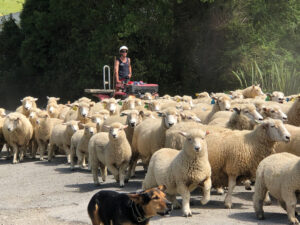
Wool you, won’t you? Luke Wilkins mustering for weaning at Wairere in December 2022. Wairere will also continue to invest in wool.
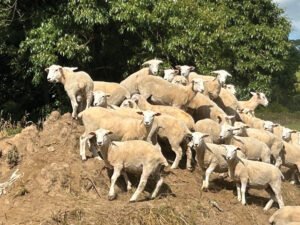
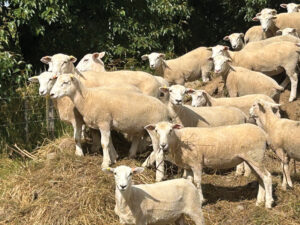
First cross Nudies 24th January shorn two weeks earlier
Blue sky for wool
In late October I flew to Christchurch to attend the AGM of WRONZ. I wanted to hear first hand about the prospect of a major manufacturing facility being built for the deconstruction of wool. The mood was bullish. Commercialisation manager Tom Hooper stated that he hoped the building of a facility would be started mid 2023. I briefly addressed the meeting to say that $10 per kg at the farm gate needed to be the target. Though that has always been the target for WRONZ, inflation may soon make that figure too low.
How long we have to wait is the other big question. Although a significant sized factory might take twenty percent of New Zealand’s current clip, the farm gate price of wool won’t increase much until a higher percentage is used for higher value uses.
Rosellas versus parakeets
Why have Australian Rosellas become so abundant after a hundred years of being introduced to New Zealand compared to our native parakeet species which are rare? And given that they occupy a similar ecological niche? Studies of their different response to predators attacking nests show that rosellas defend their nests aggressively, but parakeets are passive. There does seem to be a close parallel in the human world. Australian banks and businesses own a big chunk of New Zealand. New Zealand continues to sell off assets.
Farmers are used to weathering storms. May that resilience be rewarded by blue skies ahead.
Empire of ants
This fascinating book details the antics of 12,000 species of ants. It is estimated that there are around 2.5 million ants to every human, so who really runs the world?
Farmer ants: millions of years ago ants cultivated the first fungi, setting in motion a development so successful that neither the leafcutters nor the fungi are able to exist without it.
Slave maker ants: these species have adapted to infiltrating the nests of another species. In contrast to our hardworking image of ants, many ants are extremely lazy, so work shy that there is no longer a worker class. For this kind of lifestyle to work, the queens and males need someone to keep a roof over their heads, bring them enough food, tidy up after them, and look after their offspring.
World domination: Spanish sailors in the sixteenth century carried earth containing an Argentine ant species around the world. This species now dominates southern Europe, outcompeting a seething mass of other ant species. The conquerors’ secret lies in their greater number and unity. Instead of fighting among themselves, as is common for ants of the same species from different colonies, members of this invasive species act as one super colony and turn their accumulated aggression outwards.
Shaking up the ecosystem: on Christmas Island in the 1990s the yellow crazy ant exploded in numbers, eating everything in their path, including the red Christmas Island crab which used to have a population of millions. Two supercolonies of crazy ants are responsible for the desertification of five percent of Christmas Island, and there
is no end in sight.
What a reflection of human society around the world.
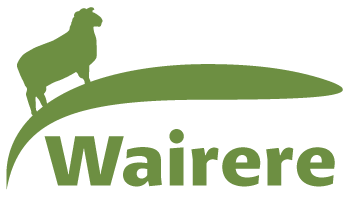
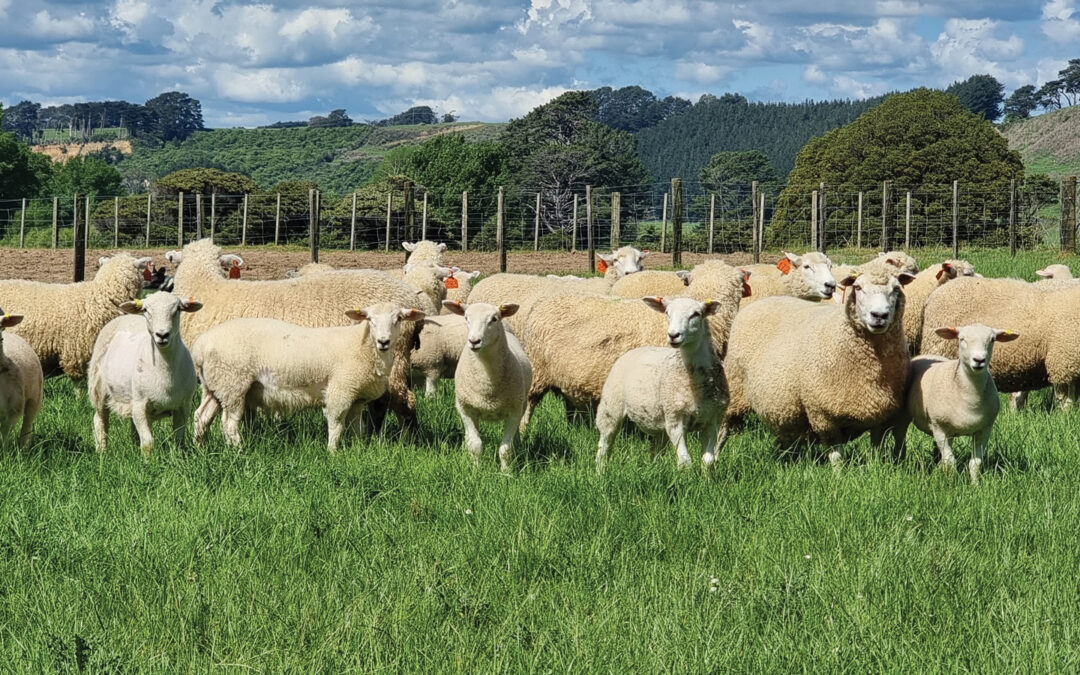
Recent Comments